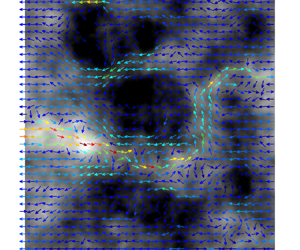Published online by Cambridge University Press: 17 May 2022

Fractures provide pathways for fluids and solutes through crystalline rocks and low permeability materials, thus playing a key role in many subsurface processes and applications. In small aperture fractures, solute transport is strongly impacted by the coupling of electrical double layers at mineral–fluid interfaces to bulk ion transport. Yet, most models of flow and transport in fractures ignore these effects. Solving such coupled electrohydrodynamics in realistic three-dimensional (3-D) fracture geometries poses computational challenges which have so far limited our understanding of those electro-osmotic effects’ impact. Starting from the Poisson–Nernst–Planck–Navier–Stokes (PNPNS) equations and using a combination of rescaling, asymptotic analysis and the Leibniz rule, we derive a set of nonlinearly coupled conservation equations for the local fluxes of fluid mass, solute mass and electrical charges. Their solution yields the fluid pressure, solute concentration and electrical potential fields. The model is validated by comparing its predictions to the solutions of the PNPNS equations in 3-D rough fractures. Application of the model to realistic rough fracture geometries evidences several phenomena hitherto not reported in the literature, including: (i) a dependence of the permeability and electrical conductivity on the fracture walls’ charge density, (ii) local (sometimes global) flow reversal, and (iii) spatial heterogeneities in the concentration field without any imposed concentration gradient. This new theoretical framework will allow systematically addressing large statistics of fracture geometry realizations of given stochastic parameters, to infer the impact of the geometry and various hydrodynamic and electrical parameters on the coupled transport of fluid and ions in rough fractures.